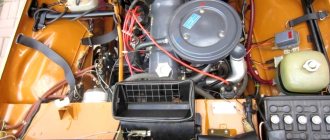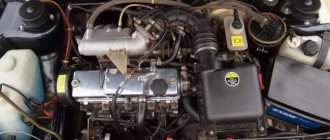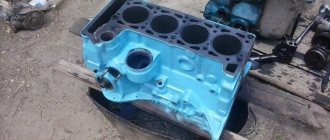December 16, 2015 Lada.Online 181 762 20
Lada 4×4 is an off-road vehicle. We know that the capabilities of an SUV depend on a number of factors, which together give the vehicle good cross-country ability. One of them is the characteristics of the power unit. Let's look at the features of the Lada 4×4 with a diesel engine.
Modifications of diesel "fours"
During the history of the production of the four, 2 diesel fuel modifications were designed:
The first version of the station wagon began to be produced in small batches in 1999. Equipped with an engine of Barnaul origin - VAZ-341. Technical specifications provide a power of only 50 horsepower with a volume of 1.5 liters. You can understand whether this is not enough or not by comparing it with the “horses” of the 1.3-liter gasoline “four”, the maximum of which is 64 horsepower. The unit is equipped with four cylinders, 2 valves each. The manufacturer of the high pressure fuel pump is German.
| Characteristics of VAZ 21045D | Numerical indicators |
| Maximum torque. | 92 Nm. |
| Fuel consumption of VAZ 2104 diesel. | 6.7 liters per 100 km in the city and 5.8 liters on the highway. |
| Toxicity standards. | Complies with Euro 2 standard. |
| Compression ratio. | 23. |
The car is also rear-wheel drive, with a 5-speed manual transmission. Tires for the diesel version are radial, with a width of 175 mm and a profile of 65%. The front suspension is independent, the rear axle is multi-link. The wheel diameter is 13 inches. The diesel modification's maximum speed and acceleration time to hundreds are the worst among all Lada 2104s. The first indicator is 125 km/h, the second - as much as 23 seconds.
The second, more powerful diesel version of the VAZ 2104 was never produced. The plant planned to improve the 21045D model and produce the VAZ 21048 with a 1.8-liter engine. The VAZ 21041 modification, which also was not put into production, had a similar fate.
Latest experiments
In 2007, Tema Plus installed an FNM engine on Chevrolet Niva for individual orders.
In 2014, on Lada 4x4 they experimented with 1.3 l 75 l. With. Fiat Multijet engine. However, it was not compatible with either the transmission due to torque limitations, or with the analog wiring diagram due to the CAN bus.
Super-auto explored the possibility of installing a 4x4 1.5 liter diesel engine from Renault Duster on the Lada 4x4 by 2015. In addition, an experimental car was created with a 100-horsepower 1.8 liter engine.
Differences from gasoline colleagues in the workshop
Changes have been introduced to the modification of the VAZ 2104 with a diesel engine.
- Additional sound insulation of the engine compartment.
- Strengthening the front springs of the suspension struts.
- The gear ratio of the main pair is reduced to 3.9.
- The exhaust duct is wrapped in a loop so as not to pollute the right rear light with soot (after all, the Euro 2 standard).
- The instrument panel is equipped with two elements: a fuel injection pump heating button and a glow plug temperature indicator.
The main difference lies in the technology itself for igniting the combustible mixture in the cylinder. Unlike the VAZ gasoline engine, the VAZ diesel engine does not mix air with fuel at the intake stage. At first, only air is started. Then, when it heats up to about 600 degrees and the piston rushes up, diesel fuel is injected.
The mixture ignites without the help of a spark from the spark plugs. VAZ diesel engines also have glow plugs. They help heat the air in the cylinder during the cold season so that it quickly reaches the optimal temperature and fuel is injected.
Features of installing a diesel engine on a VAZ 2121
If the manufacturer does not provide the opportunity to buy a Lada 4×4 with a diesel engine, then craftsmen will appear who will install it with their own hands. So, which diesel engine is suitable for the VAZ 2121? Here are the most popular models:
- Peugeot XUD-9SD (1.9 l, about 70 hp) together with Fiat Polonez gearbox.
- Peugeot XUD 11 with Fiat Polonez gearbox.
- Toyota 3C (79 hp) or 3ST (100 hp) together with Toyota Noah gearbox.
- Motor from Volkswagen Vento.
- And many others.
To install a diesel engine, a large number of modifications will be required. The simplest and most common way of such tuning is to use the engine that was installed for export versions of the SUV (XUD-9SD). Its installation requires the least amount of changes to the machine design. It has a good location of the oil intake (in the front, not in the center or rear), the oil filter (on the front left, like the Lada 4x4) and attachment points to the body. In addition, it is easy to find spare parts for this engine model. The approximate procedure is as follows:
- Engine mounts are suitable for VAZ 21215.
- The gearbox bell and the box itself fit well from Fiat Polonez.
- Rework the pan, oil intake, flywheel, exhaust system, etc.
- The easiest way is to complete all the modifications according to the documents.
In other words, no diesel engine can be installed instead of a gasoline engine without modifications. What do you think, is it necessary to change the Lada 4×4 internal combustion engine to a diesel one? If yes, which one and why? Let us remind you that you can improve off-road performance in an easier way, for example, by installing mud tires.
Keywords: 4x4 engine | 4x4 gearbox
0 0 0 0 0 0
Share on social networks:
Advantages of a “brutal” diesel engine
How do diesel lovers justify their choice? First of all, this is low fuel consumption, unlike other modifications that require a lot of gasoline. The nature of this phenomenon is more powerful ignition in the cylinder liner.
As a result, the piston receives a strong impulse and the crankshaft rotates more intensely. As a result, we get maximum torque at lower speeds. The peak torque of the VAZ 21045 diesel is 92 Nm, but this figure is achieved already at 2500 crankshaft rpm.
Maximum thrust on such an engine is also achieved at medium speeds. The “four” has a shaft speed at peak power of 4600 rpm. This is an unconditional advantage of this motor. After all, with a gasoline unit, the maximum “horsepower” is usually achievable at 5000–5500 rpm. This driving mode, with the pedal to the floor in maximum gear, is not a common occurrence for drivers of carburetor and injection cars, because the consumption is “crazy.”
Diesel allows you to use the engine's potential to the maximum during everyday driving.
Reviews
Shortly after its appearance, “Behind the Wheel” journalists tested a VAZ diesel station wagon. Reviews indicate more confident engine operation at low speeds. So, you can even start from 5th gear, and from 30 km/h smooth traction begins. When driving fast, on the contrary, you will have to shift much more often than in a gasoline car due to the shortened main gear. In any case, in terms of dynamics, a diesel car lags significantly behind. Only at low speeds is there a slight advantage.
When accelerating to 100 km/h, the petrol VAZ-2104 is 8 seconds faster. In addition, a diesel car is inferior in maximum speed by 13 km/h. When accelerating from 20 to 90 km/h, the gap is smaller (about 3 s). In addition, according to reviews from Autoreview, diesel engines have slower reactions to the gas pedal.
As for the increased noise level that usually characterizes such an engine, the VAZ diesel is noticeably louder at idle (by 6-8 dB(A)). As the speed increases, the difference decreases by 1-3 dB(A), then disappears.
As a result of the tests, journalists received a 10% difference in average fuel consumption in mixed conditions. However, the financial benefit from using a diesel engine, taking into account the prices of automobile fuel at the time of testing, was 36%. Journalists calculated that the $1,300 higher cost of the car paid for itself in 180 thousand km.
According to reviews from those who tested the VAZ-21048, it turned out to be much more balanced and, thanks to its higher torque, allowed it to switch much less frequently.
With the same engine, the Niva performed well, especially off-road.
The VAZ-3411 turned out to be similar in character to the 2121 engine. Like a gasoline engine, it performs better at high speeds. At the same time, at low speeds the thrust is lower, even than that of the VAZ-21213, that is, turbo lag is pronounced.
Disadvantages of such an engine
Although the VAZ 2104 engine uses maximum power, in this car it is too small. Another drawback is the expensive repair of fuel system parts. If the injection pump or injector breaks, the repair will cost a pretty penny. This is due to the design and purpose of these elements.
The fuel filter operates every second at a pressure of about 100 atm; its design must be very tight. All gaps between the moving parts of this device are measured almost at the “micron” level. Therefore, the slightest deviation from the normal position is fraught with a drop in pressure and damage to the pump elements. The VAZ 2104 injection pump is the most expensive component of the fuel line, in particular in terms of repairs. The fuel injector is not far behind it.
Due to the fact that diesel requires a fine fraction of fuel, the gaps in the injector are very small. Their violation leads to incorrect position of the needle and insufficient amount of diesel fuel injected into the motor.
Advantages of the VAZ-341 diesel engine
Why did manufacturers need to experiment with VAZ 2104 engines? The race among automakers at the turn of the 20th - 21st centuries led to the need for new modifications and developments in order to win “their” segment of buyers.
The main advantage of the diesel VAZ 2104 is its low fuel consumption, which, with minimal fuel prices, makes the car the most budget-friendly in the manufacturer’s line-up.
The second advantage of the model can be considered its reliability - the diesel engine and reinforced components made the car with increased performance. Accordingly, the owners did not need frequent repairs and specialized maintenance as needed to be done on the gasoline versions of the Four.
And the third advantage of the VAZ 2104 is the high engine thrust, even with a power of 52 horsepower. Therefore, the car is being purchased very actively:
- for country transportation;
- for use in large families;
- those who like to travel in large groups.
And, of course, the VAZ-341 diesel engine can withstand Russian frosts perfectly. For example, the set temperature for a cold engine start is possible even at a temperature of minus 25 degrees. This advantage is very important for Russian drivers of all categories.
Technical characteristics of VAZ 2104
| Engine | 1.3l | 1.2l | 1.5l | 1.7l | 1.5l | |
| Length, mm | 4115 | 4115 | 4115 | 4115 | 4115 | 4115 |
| Width, mm | 1620 | 1620 | 1620 | 1620 | 1620 | 1620 |
| Height, mm | 1443 | 1443 | 1443 | 1443 | 1443 | 1443 |
| Wheelbase, mm | 2424 | 2424 | 2424 | 2424 | 2420 | 2424 |
| Front track, mm | 1365 | 1365 | 1365 | 1365 | 1365 | 1365 |
| Rear track, mm | 1321 | 1321 | 1321 | 1321 | 1321 | 1321 |
| Ground clearance, mm | 170 | 175 | 170 | 170 | 170 | 170 |
| Minimum trunk volume, l | 345 | 345 | 1020 | 345 | 345 | 630 |
| Maximum trunk volume, l | 1035 | 1035 | 1475 | 1035 | 1145 | 1230 |
| Body type/number of doors | Station wagon/5 | |||||
| Engine location | Front, longitudinal | |||||
| Engine capacity, cm 3 | 1294 | 1198 | 1452 | 1690 | 1452 | 1450 |
| Cylinder type | Row | |||||
| Number of cylinders | 4 | |||||
| Piston stroke, mm | 66,8 | — | 80 | 80 | 84 | — |
| Cylinder diameter, mm | — | — | 76 | 82 | 76 | — |
| Compression ratio | 8,5 | — | 8,5 | 9,3 | 23 | 8,5 |
| Number of valves per cylinder | 2 | |||||
| Supply system | Carburetor | Carburetor | Carburetor | Mono injection | Diesel | Carburetor |
| Power, hp/rev. min. | 64/5600 | 58/5600 | 71/5600 | 79/5400 | 53/4800 | 71/5400 |
| Torque | 92/3400 | 84/3400 | 110/3400 | 127/3400 | 96/3000 | 104/3400 |
| Fuel type | AI-92 | AI-92 | AI-92 | AI-92 | Diesel | AI-92 |
| Drive unit | To the rear wheels | |||||
| Gearbox type / number of gears | Manual transmission / 4 | Manual transmission / 5 | ||||
| Gear ratio of the main pair | — | — | 4,1 | 3,9 | 4,1 | 3,91 |
| Front suspension type | Double wishbone | |||||
| Rear suspension type | One-piece bridge beam | |||||
| Steering type | Worm gear | |||||
| Turning diameter, m | 9,9 | 9,9 | 9,9 | 9,9 | 9,9 | 9,9 |
| Fuel tank volume, l | 45 | 42 | 42 | 45 | 42 | 42 |
| Maximum speed, km/h | 137 | — | 143 | 153 | 125 | 143 |
| Vehicle curb weight, kg | 1020 | 1020 | 1020 | 1050 | 1020 | 1020 |
| Permissible total weight, kg | 1475 | 1475 | 1475 | 1475 | 1475 | 1475 |
| Tires | 175/70 R13 | |||||
| Acceleration time (0-100 km/h), s | 18,5 | — | 17 | 17 | 25 | 17 |
| Fuel consumption in the urban cycle, l | 10,1 | — | 10,3 | 9,5 | — | 9,8 |
| Fuel consumption in the extra-urban cycle, l | — | — | — | — | 5,7 | — |
Disadvantages of the VAZ-341 diesel engine
Owners of diesel versions of the VAZ 2104 note several shortcomings of their cars:
- Difficulty in repairing the fuel system. Indeed, the use of low-quality fuel or neglect of the required level of maintenance quickly leads to the fact that the fuel injection pump fails. Its repair is possible only in specialized auto repair shops and is not cheap.
- When the timing belt breaks, the valves bend. That is, in case of an ordinary breakdown, you also have to spend money on buying new valves and adjusting them.
- High price. For all their efficiency in operation, VAZ 2104 diesel models are much more expensive than gasoline ones.










